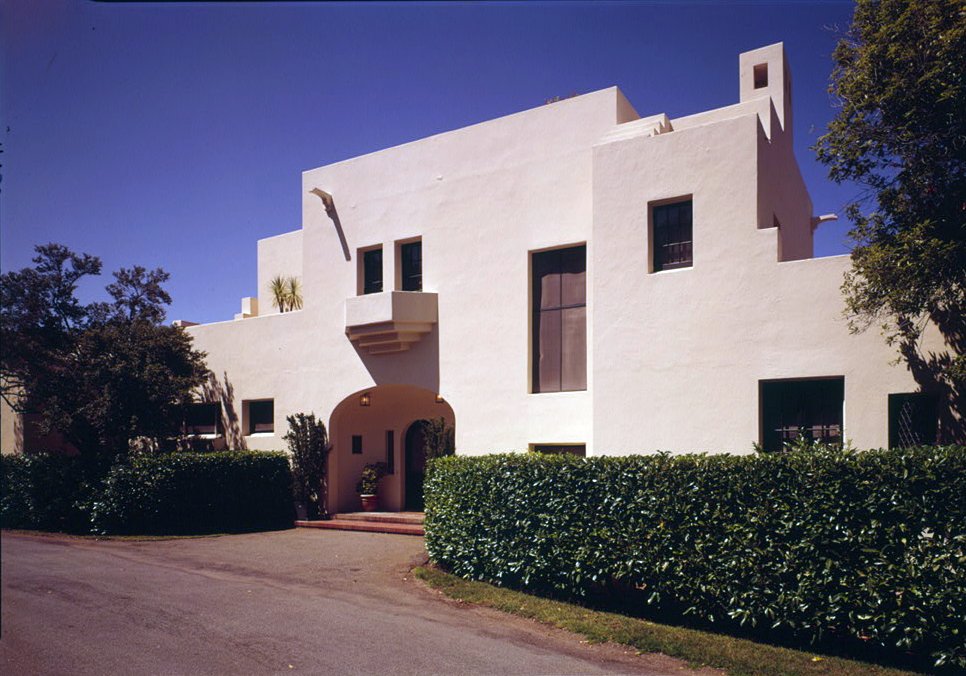- Lou Henry and Herbert Hoover House
Infobox_nrhp2 | name =Lou Henry and Herbert Hoover House
nhl=yes

caption = View of the house from the northwest
location=Palo Alto, California
lat_degrees = 37 | lat_minutes = 25 | lat_seconds = 3.76 | lat_direction = N
long_degrees = 122 | long_minutes = 10 | long_seconds = 7.96 | long_direction = W
locmapin = California
area =
built =1920
architect= Lou Henry Hoover
architecture= International/Mission Revival
designated_nhl=February 4 ,1985 cite web|url=http://tps.cr.nps.gov/nhl/detail.cfm?ResourceId=1750&ResourceType=Building
title=Hoover, Lou Henry and Herbert, House |accessdate=2008-06-18|work=National Historic Landmark summary listing|publisher=National Park Service]
added =January 30 ,1978
governing_body =Stanford University
refnum=78000786 cite web|url=http://www.nr.nps.gov/|title=National Register Information System|date=2006-03-15|work=National Register of Historic Places|publisher=National Park Service]The Lou Henry and Herbert Hoover House, located on the campus of
Stanford University inPalo Alto, California ,USA , is a large, rambling house, resembling "blocks piled up."cite web | url=http://www.cr.nps.gov/nr/travel/santaclara/anz.htm | title=Lou Henry and Herbert Hoover House | work=California's Historic Silicon Valley | publisher=National Park Service | accessdate=2007-03-12] It was designed byLou Henry Hoover , wife ofHerbert Hoover , 31stPresident of the United States . It is now the official home of the president of Stanford.History
Prior to the end of
World War I , the Hoovers had commissioned architectLouis Mulgardt to design their Stanford Home; however, Mulgardt publicized his appointment prior to the end of the war, angering the Hoovers, who felt that it was an inopportune time in the waning months of a terrible conflict to announce the construction of a large home. Mulgardt was summarily dismissed.After several consultations the Hoovers convinced
Arthur B. Clark , a Stanford art professor who practiced freelance architecture during the summer, to be their architect. Clark agreed on the condition that Mrs. Hoover design the house and that Clark, aided by architectural draftsman Charles Davus and Clark's architect son, Birge, would serve in an advisory capacity. Mrs. Hoover sketched ideas, watching construction, but when anyone told her that any of her architectural ideas weren't done, she responded, "Well, it's time someone did."The problem of size (Mrs. Hoover not wanting the house to appear too large or ostentatious) was solved by the hillside site with the house disappearing into the slope of San Juan Hill and hence appearing much smaller. The irregularly shaped house was built on a reinforced
concrete slab foundation and rises two stories in the front and three stories in the rear. Resembling early International style homes, it was the opinion of the architects that Mrs. Hoover's designs were modeled after North African Algerian homes she had seen. Elements ofMission Revival Style architecture can also be found in its design.cite news | url=http://daily.stanford.edu/article/2000/11/1/hooverHouseAwaitsHennessy | title=Hoover House Awaits Hennessy | publisher=Stanford Daily | first=Julie | last=Glasser | date=November 1, 2000 | accessdate=2007-03-13]Herbert Hoover's contribution was to order that the home be fireproof, and the walls were constructed of hollow tiles. Built from 1919 to 1920, the house was the couple's first and only permanent residence. The Hoovers lived there only a short time before Herbert was appointed Secretary of Commerce by President
Warren G. Harding in 1921, a role he continued under PresidentCalvin Coolidge . It was here that Hoover awaited the Presidential election returns in 1928, when he won againstAlfred E. Smith , and 1932, when he lost the election toFranklin D. Roosevelt . During Hoover's presidency (1929-32), the Hoover family only made brief visits to their Stanford home. They returned to this house after 1932, while maintaining a New York apartment as a second residence.After Lou's death in 1944, her husband deeded the house to Stanford University to serve as a home for university professors. It now serves as the official residence of the university president and is not open to the public.
References
Wikimedia Foundation. 2010.
